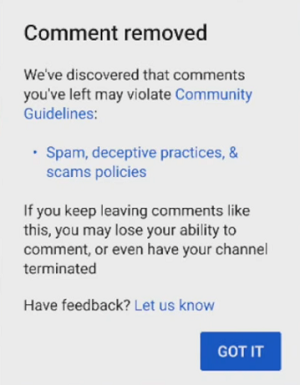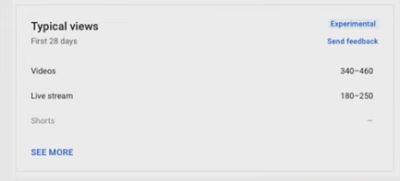YouTube’s looking to provide more context on content removals and violations, while it’s also experimenting with a new form of analytics on average video performance benchmarks, along with improved hashtag discovery, which could impact your planning and process.
First off, on policy violations – YouTube’s looking to provide more context on comment removals via an updated system that will link users through to the exact policy that they’ve violated when a comment is removed.
As explained by YouTube’s Conor Kavanagh:
“Many users have told us that they would like to know if and when their comment has been removed for violating one of our Community Guidelines. Additionally, we want to protect creators from a single user’s ability to negatively impact the community via comments, either on a single channel or multiple channels.”
The new comment removal notification aims to address this, by providing more context as to when a comment has been removed for violating the platform’s Community Guidelines.

In expansion of this, YouTube will also put some users into timeout if they keep breaking the rules. Literally:
“If someone leaves multiple abusive comments, they may receive a temporary timeout which will block the ability to comment for up to 24 hours.”
YouTube says that this will hopefully reduce the amount of abusive comments across the platform, while also adding more transparency to the process, in order to help people understand how they’ve broken the rules, which could also help to guide future behavior.
On a similar note, YouTube’s also expanding its test of timestamps in Community Guidelines policy violation notifications for publishers, which provide more specific details on when a violation has occurred in video clips.
Initially only available for violations of its ‘Harmful and Dangerous’ policy, YouTube’s now expanding these notifiers to violations related to ‘Child Safety’, ‘Suicide and Self-Harm’, and ‘Violent or Graphic’.
“If you’re in the experiment, you’ll see these timestamps in YouTube Studio as well as over email if we believe a violation has occurred. We hope these timestamps are useful in understanding why your video violated our policies and we hope to expand to more policies over time.”
On another front, YouTube’s also testing a new analytics card in YouTube Studio which will show creators the typical amount of views they get on different formats, including VODs, Shorts, and live streams.

As you can see in this example, the new data card will provide insight into the average amount of views you see in each format, based on your the last 10 uploads in each, which could provide more comparative context on performance.
Finally, YouTube’s also launched a test that aims to showcase more relevant hashtags on video clips.
“We’re launching an experiment to elevate the hashtags on a video’s watch page that we’ve found viewers are interested in, instead of just the first few added to the video’s description. Hashtags are still chosen by creators themselves – nothing is changing there – the goal of the experiment is simply to drive more engagement with hashtags while connecting viewers with content they will likely enjoy.”
So YouTube will be looking to highlight more relevant hashtags in video clips, as a means to better connect users to more video clips on the same topic.
Which could put more emphasis on hashtag use – so it could be time to upgrade your hashtag research approach in line with the latest trending topics.
All of these updates are fairly minor, but they could impact your YouTube approach, and it’s worth considering the potential impacts in your process.

 Technology
Technology 
